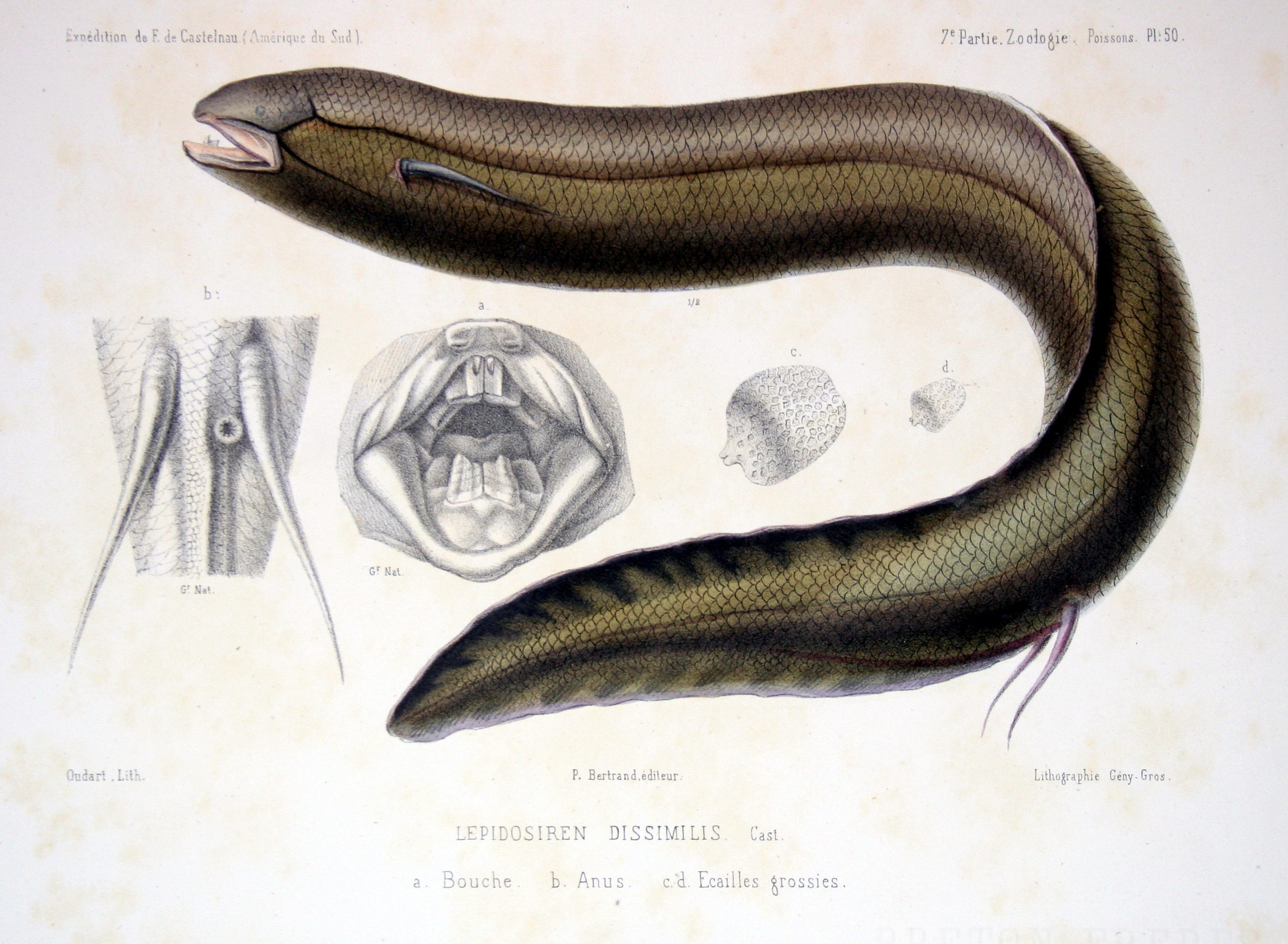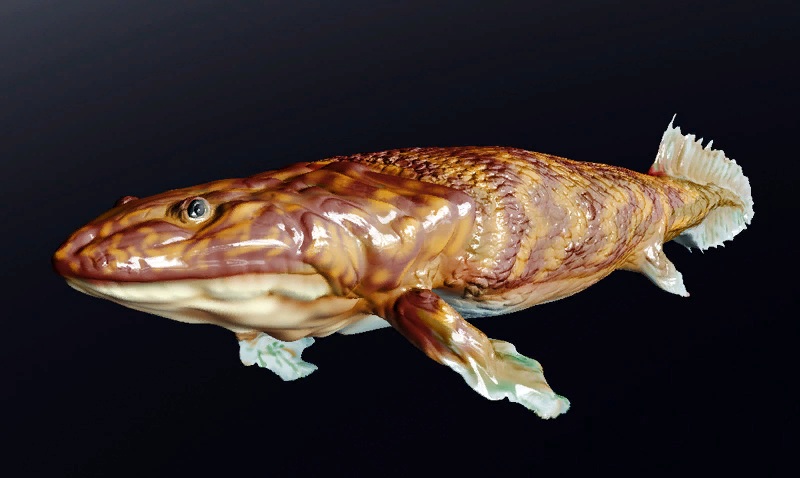|
Rhipidistia
Rhipidistia, also known as Dipnotetrapodomorpha, is a clade of lobe-finned fishes which includes the tetrapods and lungfishes. Rhipidistia formerly referred to a subgroup of Sarcopterygii consisting of the Porolepiformes and Osteolepiformes, a definition that is now obsolete. However, as cladistic understanding of the vertebrates has improved over the last few decades, a monophyletic Rhipidistia is now understood to include the whole of Tetrapoda and the lungfishes. Rhipidistia includes Porolepiformes and Dipnoi. Extensive fossilization of lungfishes has contributed to many evolutionary studies of this group. Evolution of autostylic jaw suspension, in which the palatoquadrate bone fuses to the cranium, and the lymph pumping "lymph heart" (later lost in mammals and flying birds), are unique to this group. The precise time at which the choana The choanae (singular choana), posterior nasal apertures or internal nostrils are two openings found at the back of the nasal passage b ... [...More Info...] [...Related Items...] OR: [Wikipedia] [Google] [Baidu] |
Lobe-finned Fish
Sarcopterygii (; ) — sometimes considered synonymous with Crossopterygii () — is a taxon (traditionally a class or subclass) of the bony fishes known as the lobe-finned fishes. The group Tetrapoda, a mostly terrestrial superclass including amphibians, sauropsids (reptiles, including dinosaurs and therefore birds) and synapsids (with mammals being the only extant group), evolved from certain sarcopterygians; under a cladistic view, tetrapods are themselves considered a subgroup within Sarcopterygii. The known extant non-tetrapod sarcopterygians include two species of coelacanths and six species of lungfishes. Characteristics Early lobe-finned fishes are bony fish with fleshy, lobed, paired fins, which are joined to the body by a single bone. The fins of lobe-finned fishes differ from those of all other fish in that each is borne on a fleshy, lobelike, scaly stalk extending from the body. The scales of sarcopterygians are true scaloids, consisting of lamellar bone surro ... [...More Info...] [...Related Items...] OR: [Wikipedia] [Google] [Baidu] |
Sarcopterygii
Sarcopterygii (; ) — sometimes considered synonymous with Crossopterygii () — is a taxon (traditionally a class or subclass) of the bony fishes known as the lobe-finned fishes. The group Tetrapoda, a mostly terrestrial superclass including amphibians, sauropsids (reptiles, including dinosaurs and therefore birds) and synapsids (with mammals being the only extant group), evolved from certain sarcopterygians; under a cladistic view, tetrapods are themselves considered a subgroup within Sarcopterygii. The known extant non-tetrapod sarcopterygians include two species of coelacanths and six species of lungfishes. Characteristics Early lobe-finned fishes are bony fish with fleshy, lobed, paired fins, which are joined to the body by a single bone. The fins of lobe-finned fishes differ from those of all other fish in that each is borne on a fleshy, lobelike, scaly stalk extending from the body. The scales of sarcopterygians are true scaloids, consisting of lamellar bone sur ... [...More Info...] [...Related Items...] OR: [Wikipedia] [Google] [Baidu] |
Dipnomorpha
Lungfish are freshwater vertebrates belonging to the order Dipnoi. Lungfish are best known for retaining ancestral characteristics within the Osteichthyes, including the ability to breathe air, and ancestral structures within Sarcopterygii, including the presence of lobed fins with a well-developed internal skeleton. Lungfish represent the closest living relatives of the tetrapods. Today there are only six known species of lungfish, living in Africa, South America, and Australia. The fossil record shows that lungfish were abundant since the Triassic. While vicariance would suggest this represents an ancient distribution limited to the Mesozoic supercontinent Gondwana, the fossil record suggests advanced lungfish had a widespread freshwater distribution and the current distribution of modern lungfish species reflects extinction of many lineages subsequent to the breakup of Pangaea, Gondwana and Laurasia. Lungfish have historically been referred to as salamanderfish, but th ... [...More Info...] [...Related Items...] OR: [Wikipedia] [Google] [Baidu] |
Tetrapods
Tetrapods (; ) are four-limbed vertebrate animals constituting the superclass Tetrapoda (). It includes extant and extinct amphibians, sauropsids (reptiles, including dinosaurs and therefore birds) and synapsids (pelycosaurs, extinct therapsids and all extant mammals). Tetrapods evolved from a clade of primitive semiaquatic animals known as the Tetrapodomorpha which, in turn, evolved from ancient lobe-finned fish (sarcopterygians) around 390 million years ago in the Middle Devonian period; their forms were transitional between lobe-finned fishes and true four-limbed tetrapods. Limbed vertebrates (tetrapods in the broad sense of the word) are first known from Middle Devonian trackways, and body fossils became common near the end of the Late Devonian but these were all aquatic. The first crown-tetrapods (last common ancestors of extant tetrapods capable of terrestrial locomotion) appeared by the very early Carboniferous, 350 million years ago. The specific aquatic ancestors of t ... [...More Info...] [...Related Items...] OR: [Wikipedia] [Google] [Baidu] |
Lungfishes
Lungfish are freshwater vertebrates belonging to the order Dipnoi. Lungfish are best known for retaining ancestral characteristics within the Osteichthyes, including the ability to breathe air, and ancestral structures within Sarcopterygii, including the presence of lobed fins with a well-developed internal skeleton. Lungfish represent the closest living relatives of the tetrapods. Today there are only six known species of lungfish, living in Africa, South America, and Australia. The fossil record shows that lungfish were abundant since the Triassic. While vicariance would suggest this represents an ancient distribution limited to the Mesozoic supercontinent Gondwana, the fossil record suggests advanced lungfish had a widespread freshwater distribution and the current distribution of modern lungfish species reflects extinction of many lineages subsequent to the breakup of Pangaea, Gondwana and Laurasia. Lungfish have historically been referred to as salamanderfish, but th ... [...More Info...] [...Related Items...] OR: [Wikipedia] [Google] [Baidu] |
Dipnoi
Lungfish are freshwater vertebrates belonging to the order Dipnoi. Lungfish are best known for retaining ancestral characteristics within the Osteichthyes, including the ability to breathe air, and ancestral structures within Sarcopterygii, including the presence of lobed fins with a well-developed internal skeleton. Lungfish represent the closest living relatives of the tetrapods. Today there are only six known species of lungfish, living in Africa, South America, and Australia. The fossil record shows that lungfish were abundant since the Triassic. While vicariance would suggest this represents an ancient distribution limited to the Mesozoic supercontinent Gondwana, the fossil record suggests advanced lungfish had a widespread freshwater distribution and the current distribution of modern lungfish species reflects extinction of many lineages subsequent to the breakup of Pangaea, Gondwana and Laurasia. Lungfish have historically been referred to as salamanderfish, but th ... [...More Info...] [...Related Items...] OR: [Wikipedia] [Google] [Baidu] |
Panderichthys
''Panderichthys'' is a genus of extinct sarcopterygian (lobe-finned fish) from the late Devonian period, about 380 Mya. ''Panderichthys'', which was recovered from Frasnian (early Late Devonian) deposits in Latvia, is represented by two species. ''P. stolbovi'' is known only from some snout fragments and an incomplete lower jaw. ''P. rhombolepis'' is known from several more complete specimens. Although it probably belongs to a sister group of the earliest tetrapods, ''Panderichthys'' exhibits a range of features transitional between tristichopterid lobe-fin fishes (e.g., ''Eusthenopteron'') and early tetrapods. It is named after the German-Baltic paleontologist Christian Heinrich Pander. Possible tetrapod tracks dating back to before the appearance of ''Panderichthys'' in the fossil record were reported in 2010, which suggests that ''Panderichthys'' is not a direct ancestor of tetrapods, but nonetheless shows the traits that evolved during the fish-tetrapod evolution Discovery ... [...More Info...] [...Related Items...] OR: [Wikipedia] [Google] [Baidu] |
Tristichopteridae
Tristichopterids (Tristichopteridae) were a diverse and successful group of tetrapodomorph fishes living throughout the Middle and Late Devonian. They first appeared in the Eifelian stage of the Middle Devonian. Within the group sizes ranged from a few tens of centimeters (''Tristichopterus'') to several meters (''Hyneria'' and ''Eusthenodon''). Some tristichopterids share some of the features of the elpistostegalians, a diverse clade of fishes close to the origin of (and including) tetrapods. This mainly concerns the shape of the skull and a reduction in size of the posterior fins. An old and persistent notion is that ''Eusthenopteron'' was able to crawl onto land using its fins. However, there is no evidence actually supporting this idea.M. Laurin, F. J. Meunier, D. Germain, and M. Lemoine 2007A microanatomical and histological study of the paired fin skeleton of the Devonian sarcopterygian ''Eusthenopteron foordi Journal of Paleontology'' 81: 143–153. All tristichopterids h ... [...More Info...] [...Related Items...] OR: [Wikipedia] [Google] [Baidu] |
Lymph Heart
A lymph heart is an organ which pumps lymph in lungfishes, amphibians, reptiles, and flightless birds back into the circulatory system. In some amphibian species, lymph hearts are in pairs, and may number as many as 200 in one animal the size of a worm, while salamanders have as many as 23 pairs of lymph hearts. Lymph hearts are thought to have evolved in ''Rhipidistia''. Mammals have lost the lymph heart as a centralized organ, instead having the lymph vessel themselves contract to pump lymph. and other amphibians The lymphatic system of a frog consists of lymph, lymph vessels, lymph heart, lymph spaces and spleen. Some mast cells can also be found in the lymphatics of the tongue of some of the frog species. Lymphatics and lymph As lymph is a filtrate of blood, it closely resembles the plasma in its water content. Lymph also contains a small amount of metabolic waste and a much smaller amount of protein than that of blood. Lymph vessels carry the lymph and, in the frog, open ... [...More Info...] [...Related Items...] OR: [Wikipedia] [Google] [Baidu] |
Early Devonian
The Early Devonian is the first of three Epoch (geology), epochs comprising the Devonian period, corresponding to the Lower Devonian Series (stratigraphy), series. It lasted from and began with the Lochkovian Stage , which was followed by the Pragian from and then by the Emsian, which lasted until the Middle Devonian began, . During this time, the first Ammonoidea, ammonoids appeared, descending from Bactritida, bactritoid Nautiloidea, nautiloids. Ammonoids during this time period were simple and differed little from their nautiloid counterparts. These ammonoids belong to the order Agoniatitida, which in later epochs evolved to new ammonoid orders, for example Goniatite, Goniatitida and Clymeniida. This class of cephalopod molluscs would dominate the marine fauna until the beginning of the Mesozoic Era. References {{Geological history Early Devonian, Geological epochs Devonian geochronology, *01 ... [...More Info...] [...Related Items...] OR: [Wikipedia] [Google] [Baidu] |
Thysanolepidae
Osteolepiformes, also known as Osteolepidida, is a group of prehistoric lobe-finned fishes which first appeared during the Devonian period. The order contains the families Canowindridae, Megalichthyidae, Osteolepididae and Tristichopteridae. The order is generally considered to be paraphyletic because the characters that define it are mainly attributes of stem tetrapodomorphs. Below is a cladogram A cladogram (from Greek ''clados'' "branch" and ''gramma'' "character") is a diagram used in cladistics to show relations among organisms. A cladogram is not, however, an evolutionary tree because it does not show how ancestors are related to ... showing the paraphyly of Osteolepiformes compiled and modified from Ahlberg and Johanson (1998). See also Swartz (2012). Osteolepiformes is marked by the green bracket. References External linksTree of Life Tetrapodomorphs Prehistoric fish orders Paraphyletic groups {{paleo-lobefinned-fish-stub ... [...More Info...] [...Related Items...] OR: [Wikipedia] [Google] [Baidu] |
Kenichthys
''Kenichthys'' is a genus of sarcopterygian fish from the Devonian period, and a member of the clade tetrapodomorpha. The only known species of the genus is ''Kenichthys campbelli'' (named for the Australian palaeontologist Ken Campbell), the first remains of which were found in China in 1993.Chang, M. and Zhu, M. (1993) A new Middle Devonian osteolepidid from Qujing, Yunnan. ''Mem. Assoc. Australas. Palaeontol.'' 15 183-198 The genus is important to the study of the evolution of tetrapods due to the unique nature of its nostrils, which provide vital evidence regarding the evolutionary transition of fish-like nostrils to the tetrapod choanae.Zhu, M. and Ahlberg, P. (2004) The origin of the internal nostril of tetrapods. ''Nature'' 432 94-97 Description ''Kenichthys'' was a small tetrapodomorph, with a skull about long. While only areas of the front of the body are known, it seems likely that ''Kenichthys'' would have been similar in general body form to other basal sarcoptery ... [...More Info...] [...Related Items...] OR: [Wikipedia] [Google] [Baidu] |





